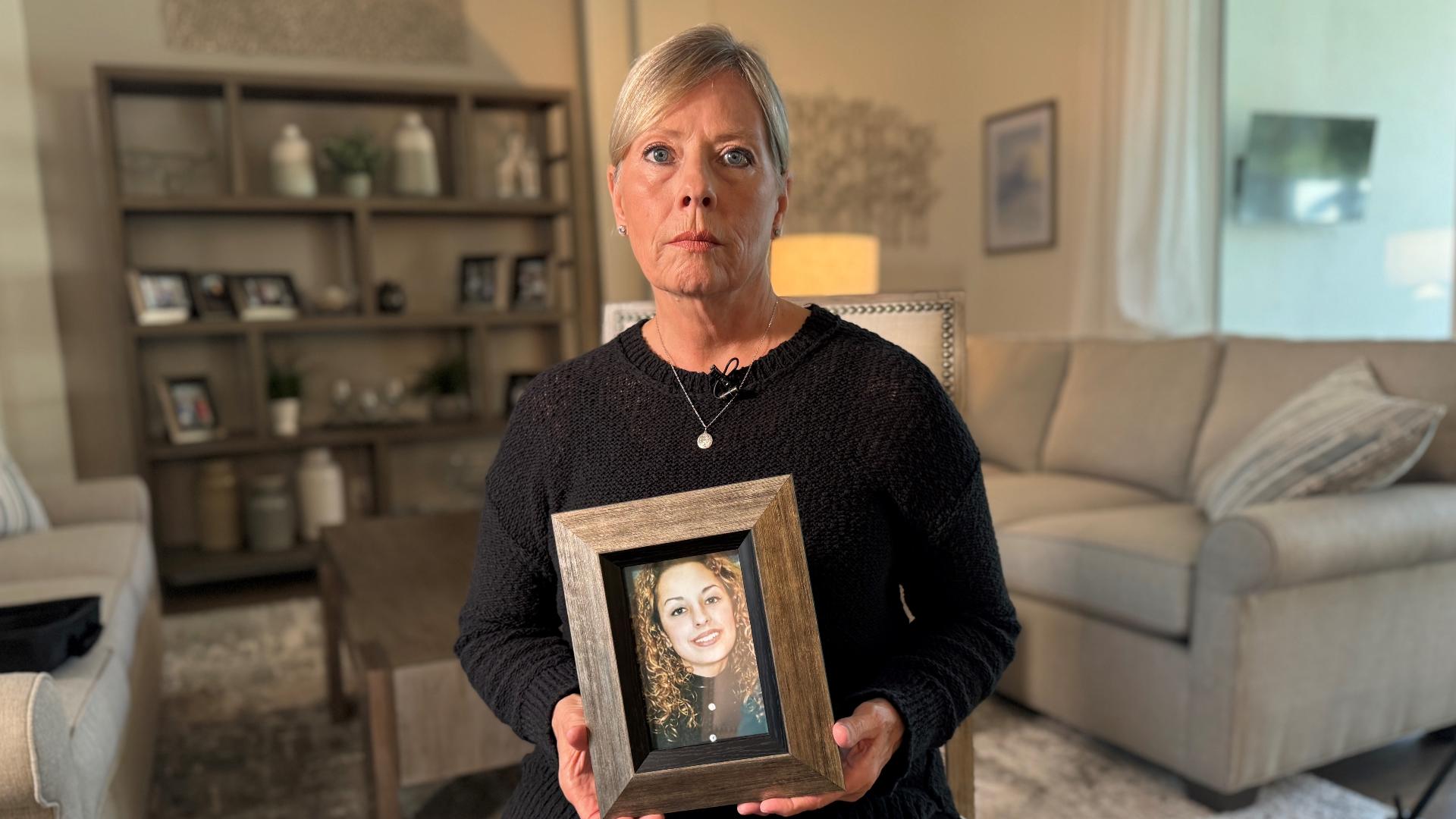JACKSONVILLE, Fla. — Roya Sadigh had recently gotten engaged when the car she was riding in with her fiancé slid underneath a tractor trailer. She died instantly.
“She didn't make it to the hospital,” Lois Durso, Roya’s mother, said. “Actually, they found her hair on the tires of the trailer."
This month marks 20 years since that accident claimed the life of Durso’s 26-year-old daughter. Not a day goes by that she doesn't think about her. She says her daughter's death was preventable, and she's been pushing for a federal law to make sure this doesn't happen to anyone else.
“I mean, I lost my child,” Durso said, “The government, the Department of Transportation, they've known about underride well before my daughter's crash and nothing was ever done to prevent it on the sides of tractor trailers.”
Roya died in a 'side underride' crash. That's when a passenger vehicle goes under the side of a tractor trailer.


“The engine and everything that's there to protect a frontal impact before it gets to a vehicle occupant is rendered irrelevant in a side underride, because the vehicle just goes right underneath the semi-trailer,” Attorney Joe Camerlengo said. “Unfortunately, most of those crashes are fatal or involve catastrophic injury.”
Camerlengo, the founder of The Truck Accident Law Firm in Jacksonville, has seen firsthand the devastating effects.
“My client's case, it was a full-size pickup truck that literally went right under the trailer and came out on the other side. And you saw what was left of it: nothing,” Camerlengo said.
He says these types of crashes can be deadly even at low speeds. “The first impact is the windshield. Literally, side underrides have been fatal at 15 miles an hour. It doesn't take much, because there's no protection.”
But technology exists right now that can stop cars from going under tractor trailers. Crash test video shows how a side underride guard can keep cars from going underneath 18-wheelers.
“In those crashes up to 40 miles an hour, we saw very low risk of a serious injury,” Matthew Brumbelow said. “We saw very low risk of a serious injury. We also then ran just essentially to illustrate the problem the test without the side underride guards. And you would expect a fatality in that kind of crash based on head contact with the side of the trailer as it intrudes, and almost no reduction in speed before that impact between the dummy and the trailer side.”
Brumbelow is a senior research engineer at the Insurance Institute for Highway Safety. He says while there are no regulations for side underride guards in the U.S., changes are necessary.
“We do believe that side underride guards should be required and should be regulated,” Brumbelow said. “We believe that hundreds of lives a year would be saved by requiring side underride guards.”
Camerlengo explains why he believes side guards are not mandated in the U.S.
“It’s just the trailer manufacturers and politics… Really, it's about money,” Camerlengo said. “We've all seen those trailers with fuel skirts on them that are wobbly. Those cost about $1500 for double that, for $3000 you can get a rigid side under guard which will have the same fuel efficiency. They'll make it up in fuel savings in a long-haul truck in less than a year, but will prevent vehicles from going under at angles, which most of those crashes are not direct T-bone.”
The National Highway Traffic Safety Administration (NHTSA) declined our request for an interview. But its report to Congress in June 2024 said side underride guards are 97% effective at mitigating fatalities at speeds up to 40 miles per hour and would save about 17 lives a year if all trailers are equipped with them. However, its analysis found the cost would be more than the benefit. "The net benefits for a side underride guard requirement on trailers and semitrailers are estimated to be negative and in the range of -$1.038 billion to -$844 million," the report says.
The American Trucking Associations it would cost $35 billion to install these guards on all existing trailers. David Heller with the Truckload Carriers Association believes there is a better solution.
“Rather than justifying the crash, like a side underride guard would do, the reality is something like automatic emergency braking (AEB) if it was placed on both trucks and passenger vehicles, and you're starting to see it more and more, that would go a much further way to preventing these crashes altogether,” Heller said.
Joe Young, a spokesperson with The Insurance Institute for Highway Safety said, “AEB systems are proving to be highly effective in some crash scenarios, but they still can’t and won’t prevent every crash. We need to continue to look at other ways to reduce the harm from vehicle crashes. Effective rear and side underride guards can help ensure that crashes between passenger vehicles and large trucks are more survivable.”
Durso and those who want side guards mandated say the number of deaths attributed to this type of accident is grossly underestimated because only 17 states have an underride field on police accident reports. Florida and Georgia are among 33 states that do not.
“Literally the only way a Florida crash gets reported as underride is if the officer writes side under ride in the description, that is it,” Camerlengo said.
Like so many others, Roya's death was not counted as a side underride death because it was not written on the crash report.
“We can't get an accurate count, and that's one of the things that the industry does is, you know, there's not enough people dying in order to do something and to prevent underride,” Durso said.
While Durso has been advocating for years for a federal mandate to require side guards she also wants an underride box on every police report in the country because she believes the data collected will help spark change. NTSA this year started recommending states collect this information in their police crash reports and electronic crash data systems.|
“I think people will be shocked to know how many people throughout the country are dying of underride,” Durso said. “It happens in the blink of an eye, and there are ways to prevent it. But, you know, if nobody knows about it, then nothing gets done.”
We have reached out to Florida and Georgia officials to ask if they plan to start collecting it and we are still waiting for an answer.
"When we have information to pass along, we will reach out," Molly Best, Spokesperson for Florida Department of Highway Safety and Motor Vehicles, said.
Statement from The American Trucking Associations Spokeswoman Jessica Gail
The trucking industry proactively invests $14 billion annually in safety training, technology, and other measures that extend beyond those required by law. Today's trucks are equipped with advanced safety features like automatic emergency braking, lane departure warning systems, forward-collision and blind-spot warnings, to name but a few. The American Trucking Associations actively supports a range of solutions to reduce, mitigate, and prevent crashes of all types – including underride-related crashes – involving all types of road users and is engaged in federal and state-level efforts to drive these solutions forward.
ATA believes equipment mandates should be based on sound engineering while considering real-world operations and weighing unintended consequences. The federal government’s own analysis cites significant, unresolved challenges posed by side underride guards, such as railroad crossings and other infrastructure designs that could ensnare this equipment and create an even greater safety hazard. Moreover, NHTSA concluded its proposal to require guards on new trailers would have a net-negative benefit of $1 billion, which pales in comparison to the $35 billion it would cost to install these guards on all existing trailers. This inordinate, unfunded mandate would kill current investments in innovative, lifesaving technologies that prevent crashes from occurring in the first place by forcing companies to use divert limited resources to less-effective, costly underride equipment.
ATA has remained engaged in conversations at the federal level regarding appropriate measures to mitigate and prevent side underride crashes through direct participation in and representation on NHTSA’s Advisory Committee on Underride Protection (ACUP), created under the 2021 Infrastructure Investment and Jobs Act. Additionally, we support DOT taking a more comprehensive approach on a crash-prevention strategy, including the deployment of advanced safety technologies and enforcement to prevent distracted and aggressive driving, which, in 2020, contributed to more than 3,142 deaths and an estimated additional 324,652 injuries, according to NHTSA.
Full statement from the NHTSA:
It is unacceptable that more than 40,000 people are losing their lives every year in traffic crashes in the United States, which is why the U.S. Department of Transportation launched the National Roadway Safety Strategy, a systemwide effort involving all levels of government, including federal, state, and local, to address this crisis. The National Highway Traffic Safety Administration plays a critical role in implementing this strategy, including a broad array of efforts to address motor vehicle underride safety, such as improving data collection, launching critical safety research, conducting comprehensive analyses, establishing a formal underride advisory committee to gather advice from diverse stakeholders, and proposing regulations that would prevent and mitigate underride crashes, including automatic emergency braking systems.

